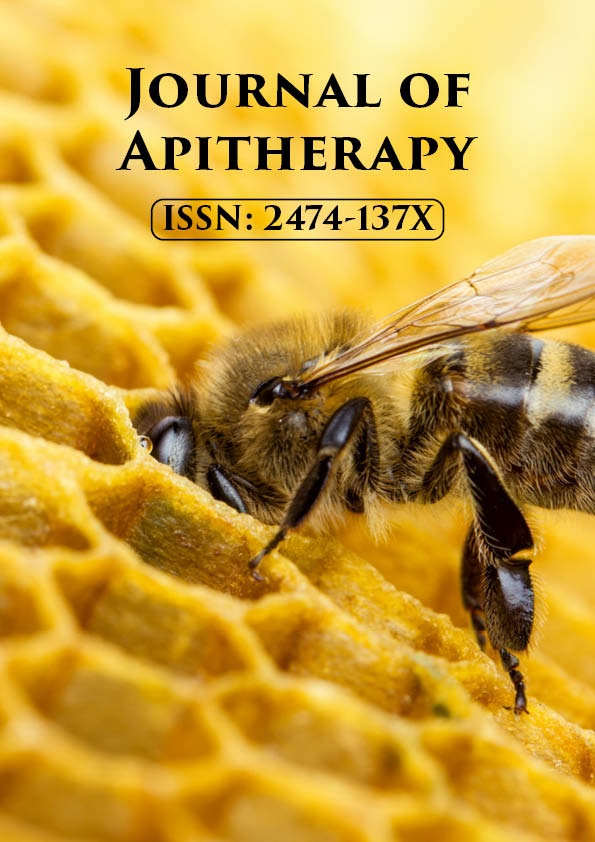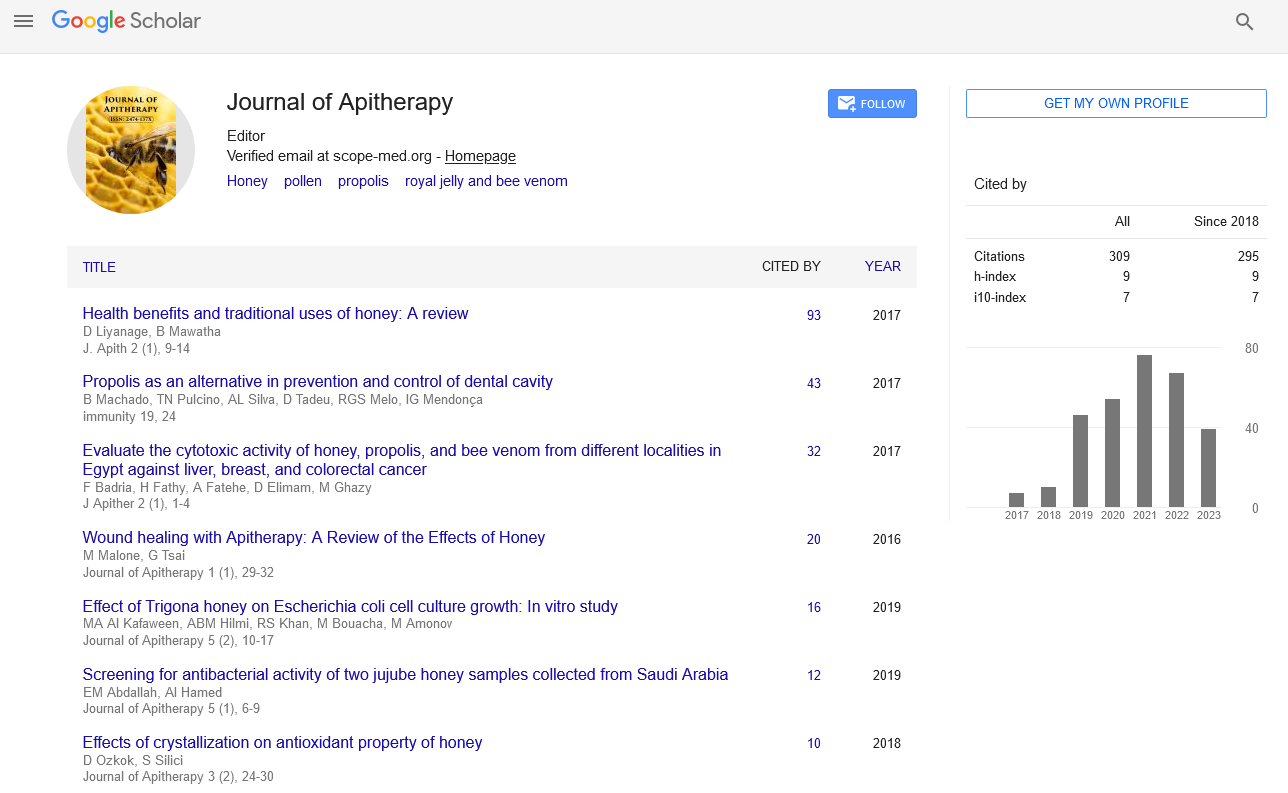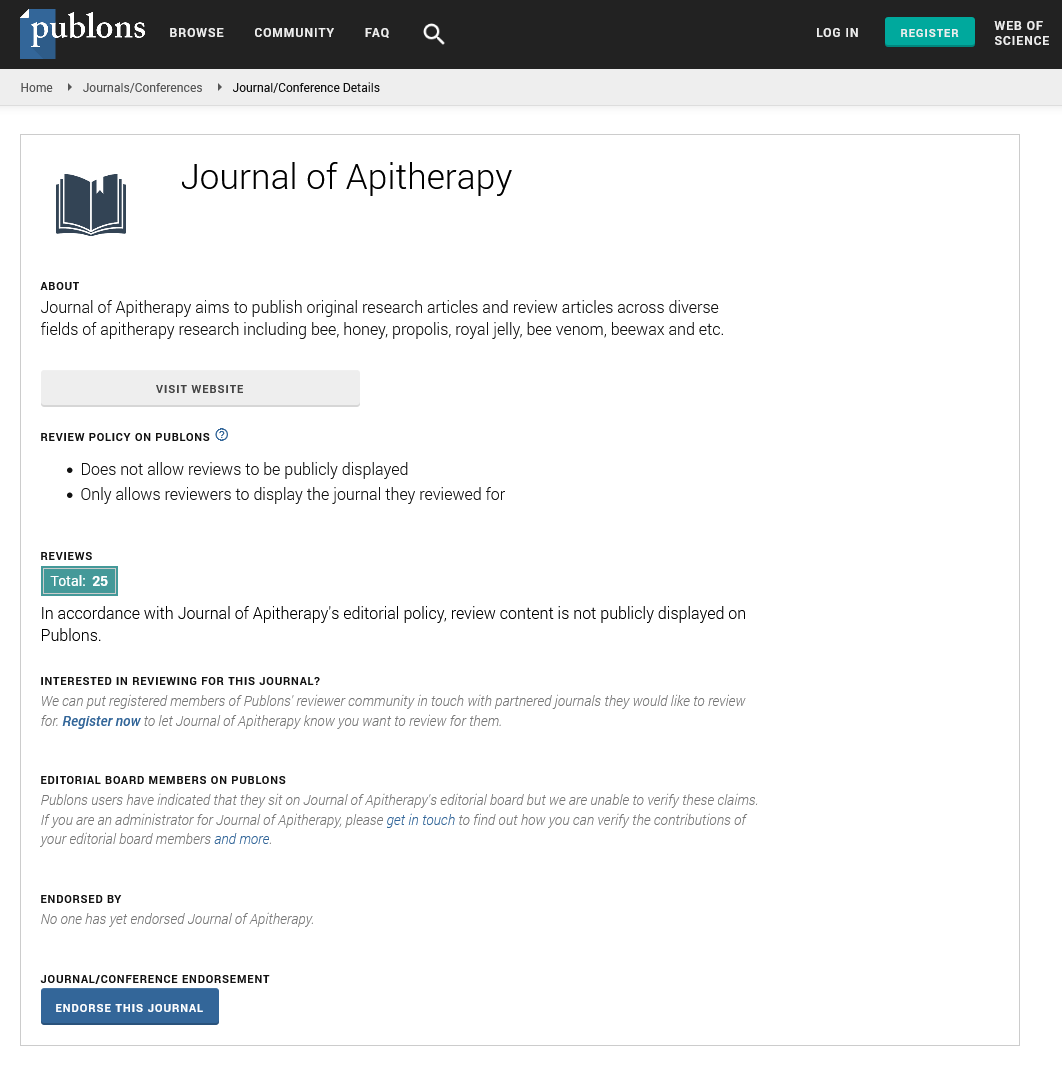Commentary - Journal of Apitherapy (2023)
Bee Venom for Arthritis: Nature's Sting against Joint Pain
Phillip Urbach*Phillip Urbach, Department of Apitherapy, University of Washington, Seattle, USA, Email: Phillip@gmail.com
Received: 09-Oct-2023, Manuscript No. JAPITHERAPY-23-123326; Editor assigned: 11-Oct-2023, Pre QC No. JAPITHERAPY-23-123326 (PQ); Reviewed: 25-Jan-2023, QC No. JAPITHERAPY-23-123326; Revised: 02-Nov-2023, Manuscript No. JAPITHERAPY-23-123326 (R); Published: 09-Nov-2023
Description
In the quest for novel and natural remedies for arthritis, bee venom has emerged as a fascinating subject of research and therapeutic exploration. Apitherapy, the medicinal use of bee products, including bee venom, has been practiced for centuries in various cultures. The venom's unique composition, containing a mix of peptides, enzymes, and anti-inflammatory compounds, has sparked interest in its potential to alleviate the symptoms of arthritis and other inflammatory joint conditions. This article delves into the science behind bee venom therapy, its historical roots, current research findings, and the prospects it holds for individuals seeking relief from the burdens of arthritis.
Bee venom therapy for arthritis
The application of bee venom for arthritis involves controlled exposure to the venom through bee stings or venom injections. The idea is to stimulate the immune system and trigger anti-inflammatory responses that may alleviate joint pain and inflammation associated with arthritis. While the mechanisms of action are not fully understood, it is believed that bee venom may influence various aspects of the immune and inflammatory pathways.
Research findings and clinical evidence
Research on the efficacy of bee venom therapy for arthritis has yielded mixed results. Some studies and clinical trials have reported positive outcomes, while others have suggested limited benefits. It is important to note that the available evidence is still evolving, and further research is needed to establish the safety and effectiveness of bee venom therapy for arthritis.
Rheumatoid Arthritis (RA): Several studies have explored the use of bee venom therapy in rheumatoid arthritis, an autoimmune condition characterized by joint inflammation. Some research suggests that bee venom injections may reduce the severity of symptoms and improve joint function in individuals with RA.
OsteoArthritis (OA): The application of bee venom for osteoarthritis, a degenerative joint disease, has also been investigated. Studies have indicated potential benefits, including pain reduction and improved physical function, although the evidence is not yet conclusive.
Anti-inflammatory effects: The anti-inflammatory properties of bee venom have been observed in laboratory studies, where it has been shown to modulate the activity of immune cells and reduce the production of inflammatory substances.
Pain relief: Bee venom therapy may exert analgesic effects by influencing pain perception and reducing nerve sensitivity. Some individuals report relief from joint pain after bee venom treatments.
Considerations and cautions
While bee venom therapy holds promise, there are important considerations and cautions:
Allergic reactions: Bee venom can cause allergic reactions, ranging from mild local swelling to severe anaphylaxis. Individuals with a known allergy to bee stings should exercise extreme caution, and the therapy should be administered under the supervision of qualified healthcare professionals.
Individual responses: The response to bee venom therapy can vary among individuals. What works for one person may not be effective or safe for another. Careful assessment and monitoring are essential to determine the suitability of the treatment for each patient.
Standardization and regulation: The lack of standardized protocols for bee venom therapy poses challenges in terms of consistency and safety. The formulation, dosage, and administration methods may vary, emphasizing the need for standardized guidelines and regulatory oversight.
Scientific rigor: While some studies suggest benefits, more rigorous, well-designed clinical trials are needed to establish the efficacy and safety of bee venom therapy for arthritis. The placebo effect and the complexity of arthritis as a condition make it crucial to rely on robust scientific evidence.
Therapeutics of bee venom
As researchers continue to explore the potential of bee venom therapy for arthritis, several areas warrant attention for the advancement of this field:
Clinical trials: Rigorous, large-scale clinical trials are needed to establish the efficacy and safety of bee venom therapy for different types of arthritis. These trials should follow standardized protocols and include diverse patient populations.
Mechanistic understanding: A deeper understanding of the mechanisms by which bee venom exerts its effects on joint inflammation is crucial. This knowledge can inform targeted approaches and enhance the precision of bee venom therapy.
Individualized treatment: Considering the variability in individual responses, future research should explore personalized approaches to bee venom therapy. Tailoring treatments based on specific patient characteristics may optimize outcomes.
Combination therapies: Investigating the potential synergies between bee venom therapy and existing arthritis treatments could open avenues for combination therapies that provide enhanced benefits.
Bee venom therapy for arthritis represents a captivating intersection of traditional medicine, natural remedies, and modern scientific inquiry. While the potential benefits are intriguing, the road ahead involves navigating through the complexities of individual responses, allergic risks, and the need for robust scientific evidence. For individuals considering bee venom therapy, collaboration with healthcare professionals is paramount. A thorough evaluation of risks and benefits, along with informed decision-making, ensures that the therapy aligns with individual health goals and safety considerations.







